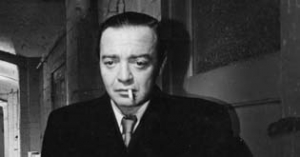Gallery
All Pictures (6)Biography
Ladislav Loewenstein was born June 26, 1904, in Rószahegy in the Carpathian Mountains, Hungary, as the son of a merchant. In 1908, his mother died, and his father remarried. Ladislav attended a German private school in Braila and, after his family relocated to Mölding near Vienna, a Viennese secondary school. After his graduation he started an apprenticeship at a bank upon his father's wish but soon provoked his dismissal. After a time full of privation, he joined Jacob Moreno's impromptu theatre. The improvisational method of the later founder of the "psycho drama" fundamentally influenced Ladislav's manner of expression. He also devoted himself to psychoanalysis, his lifelong hobby.
Moreno gave him his stage name Peter Lorre before he became a cast member of Leo Mittler's Lobe-Theater and Thalia Theater in Breslau in 1924. In 1925/26, Lorre performed at Zürich's Schauspielhaus, from 1926 to 1927, he played at Kammerspiele Vienna, and in 1928, he went to Vienna's Carl-Theater. In the spring of 1929, Bert Brecht gave him the role of Fabian in his production of Fleißer's "Pioniere in Ingolstadt" ("Pioneers in Ingolstadt") at Berlin's Theater am Schiffbauerdamm. Subsequently, Lorre performed at Schiffbauerdamm and at Volksbühne, for instance, as St. Just in "Dantons Tod" ("Danton's Death") and as Moritz Stiefel in "Frühlingserwachen" ("Spring Awakening", 1929).
A few months after his controversial performance as Galy Gay in "Mann ist Mann" ("A Man's A Man") in February 1931, at Staatstheater, directed by Bert Brecht who also filmed the production, Lorre became a film star with his debut on the movie screen as the child murderer Beckert in Fritz Lang's sound film "M". However, Lorre stayed at the theatre and, for instance, performed at Kabarett der Komiker in 1932. Furthermore, he played smaller, often comedic roles in films like "Die Koffer des Herrn O.F." ("The Thirteen Trunks of Mr. O.F.")
On March 4, 1933, the Jew Lorre left Germany and at first went to Vienna, then to Paris where he starred in the film "Du haut en bas". In 1934, he went to England to star in the Hitchcock movie "The Man Who Knew Too Much". During the shooting of the film, he married the actress Cäcilie Lvovsky who later named herself Celia Lovsky.
In July 1934, he went to Hollywood with a contract from Columbia. Lent to M-G-M for his first US film "Mad Love", Lorre made a memorable performance as the bald-headed "mad scientist" Dr. Gogol: "It was to Lorre alone we owed the goodness, the tenderness of the vicious man. Those marble pupils in the pasty spherical head are like the eye-pieces of a microscope through which you can watch the tangled mind laid flat on the slide: love and lust, hatred of itself and despair jumping out at you from the jelly." (Greene, 1936).
In 1936, Lorre went to Century Fox because he had been restrictd to the image of a murderer and horror star in his following films. But at Century Fox, he had to play another fixed role – much to his chagrin – in the series of "Mr. Moto" films. When his contract ended in 1939, he worked for four years without any obligations to a studio but still did not receive any role offers that went beyond his image.
In 1941, Lorre's career gained new momentum after he played the part of Joel Cairo in the Warner Bros. film "The Maltese Falcon". As a result, he made several films for the studio with his friend Humphry Bogart and the tall and large Sydney Greenstreet ("'Laurel & Hardy' of Crime"; Sennett 1979). Lorre then received a contract from Warner from 1943 to 1946. In 1945, he married his second wife, the actress Kaaren (Karin) Verne.
Since 1941, Lorre stood in close contact with Bert Brecht, who wrote several film exposes for him but none of the studios was interested in buying one. Even the business partners of Lorre's own company Lorre Incorporated that he had set up in 1946, rejected the screenplays. For his company, Lorre toured with readings and started to increase his work for the radio that he had already begun at the end of the 1930s. In 1949, his company went bankrupt and in June 1949, Lorre returned to Europe. He toured Great Britain and Germany with readings of Poe's "A Tell-Tale Heart" and worked in refugee camps.
In 1950/51, Lorre finished the "Der Verlorene" ("The Lost One") as co-author, director and leading actor. In the film, a scientist turns into a women's killer but is prevented from atonement by the Nazi regime because his research is too important. Despite positive reviews, "Der Verlorene" flopped at the box office and Lorre returned to the USA with his third wife Annemarie Brenning.
He played theatre at the East Coast in "A Night at Madame Tussaud's" before the film business took notice of him again after his performance in "Beat the Devil". Lorre got smaller parts, for instance, in Irwin Allen's color wide screen films. After an illness had turned him plump, he was often used in films as a chubby eyecatcher.
Lorre then worked a lot for TV productions, mainly in roles, that referred to his horror star image. He became popular once more after his collaboration with Vincent Price and Boris Karloff in two films by Roger Corman, "Tales Of Terror" and "The Raven", and in Jacques Tourneur's film "The Comedy Of Terrors". In the films, Lorre expressed his comedic as well as his scary talents in a likable vicious manner.
Peter Lorre died in the night from March 22 to 23, 1964, in his apartment at Hollywood Boulevard.
